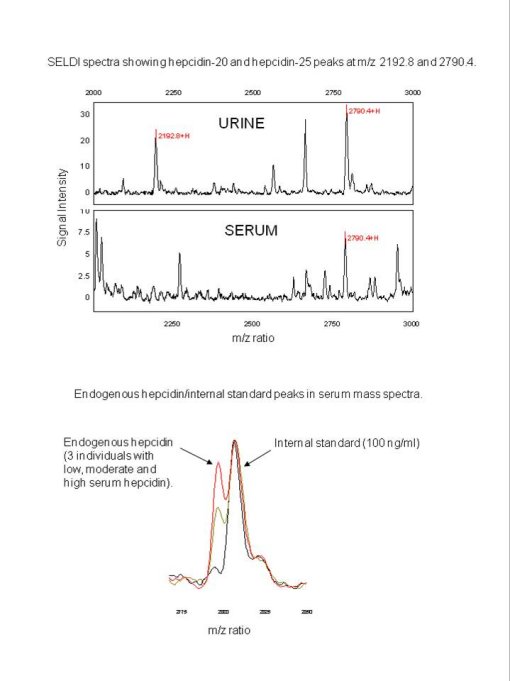We assay human hepcidin in serum or urine by SELDI-TOF-MS using synthetic stable isotope labelled hepcidin as an internal standard (which is 10 Daltons heavier than the endogenous hepcidin). The concentration of hepcidin in a sample is calculated from the mass spectra using the peak height ratio of endogenous and labelled hepcidin. This generates a reproducible quantitation of hepcidin.
The stable isotope labelled standard is added to the serum or urine under denaturing conditions (usually at 100 ng/ml) and then applied to Cu2+ loaded IMAC SELDI chips. Hepcidin binds to this chromatographic surface and is enriched whilst many potentially interfering components of the sample can be washed away. Following this on-chip clean up the sample is overlayed with sinapinic acid, excited by a laser and the resulting positively charged peptide ions measured by time-of-flight mass spectrometry.
The use of the very sensitive SELDI-TOF analyser, on-chip sample preparation and an internal stable isotope labelled standard allows straightforward high-throughput hepcidin measurements in human serum, plasma and urine. Currently this method cannot be used to quantify hepcidin at extremely low concentrations (LLOD ~ 5 ng/ml), to analyse tissue homogenates or to measure hepcidin in other species. We are now developing both MALDI and LC-MS based quantitative methods to overcome these issues.
The Image below shows a typical SELDI spectra of human urine and serum with the hepcidin-25 peak evident at m/z 2790 in both fluids and hepcidin 20 at m/z 2193 in urine. The lower panel shows three human serum samples (containing low, medium and high levels of hepcidin) each spiked with 100ng/ml of stable isotope labelled hepcidin.
